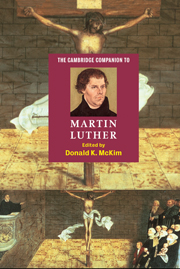1 - Luther’s life
from Part I - Luther’s life and context
Published online by Cambridge University Press: 28 May 2006
Summary
YEARS AS A STUDENT
From the outside, Luther's life passed by simply and steadily. With few exceptions, his whole life took place within the territories of Thuringia and Saxony, mostly in Wittenberg, the electoral capital at the Elbe river, and its surroundings. Only a few journeys led Luther beyond this small sphere of life: on behalf of his order to Rome (1510/11), to Cologne (1512) and Heidelberg (1518); later on behalf of a Reformation consensus to Marburg (1529), and also on his own behalf to Augsburg (1518) and Worms (1521). Equally, with regard to his profession, Luther's was a remarkable and steady character. From entering the monastery through to his last moment, Luther always remained a man of the word: as a preacher, professor and writer.
During Luther’s life the horizon of world history and humanities was in the process of becoming radically changed. The following names must stand for many others representing this era: the two emperors Maximilian I and Charles V, the popes Leo X, Clemens VII and Paul III (Council of Trent), as well as the names of such artists and scientists as Raphael, Michelangelo, Dürer, Copernicus and Paracelsus. However, as far as Luther is concerned these changes could be deceptive because his childhood and youth had not been touched by the spirit of humanism or of the Renaissance. Limited to the provincial surroundings of his hometown, Luther grew up as a typical child of the late Middle Ages – just like thousands of other boys around him.
- Type
- Chapter
- Information
- The Cambridge Companion to Martin Luther , pp. 3 - 19Publisher: Cambridge University PressPrint publication year: 2003
- 1
- Cited by



